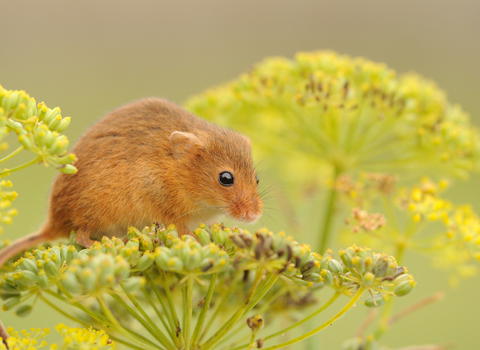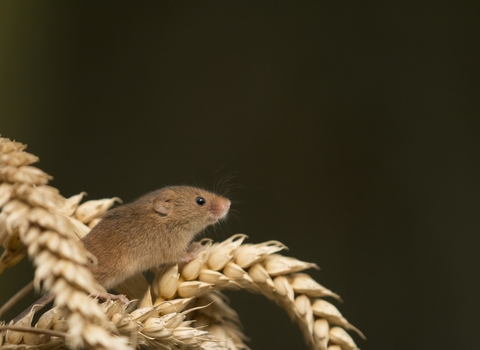
Harvest mouse ©Amy Lewis
Harvest mouse
Scientific name
Micromys minutusWhen to see
January to DecemberSpecies information
About
The tiny harvest mouse lives in long tussocky grassland, reedbeds, hedgerows, farmland and around woodland edges. It is mainly vegetarian, eating seeds and fruits, but will also eat invertebrates. Harvest mice build a spherical nest of tightly woven grass, high-up in the tall grasses, in which the female will give birth to around six young.How to identify
The harvest mouse has pale, ginger or yellow fur, and a white belly. Its tail is almost hairless and nearly as long as its body.Distribution
Found in England, south of Yorkshire.In our area
Records indicate these little creatures have moved to rushy or wet pastures that are only lightly grazed if at all, or cut once a year for hay. They have even been found in reed-beds over water. They have recently been surveyed on The Mosses in the north of the county , near Wem Moss. We are managing this site for harvest mice, ensuring they have plenty of long tussocky grass to make their nests.
Harvest mice make their nests during the summer to use for rearing young. Once the juveniles leave their nests, the parents also abandon the nests and move onto drier land as the autumn sets in. By September, it is only the nests that act as evidence that harvest mice even inhabit an area! Because of their size and diminutive lifestyle, these tiny rodents are very hard to spot and very little in known about their numbers in Shropshire.
Did you know?
The harvest mouse is the only British mammal to have a prehensile tail: it can use it like a fifth limb, holding on to grass stems with it.Records indicate these little creatures have moved to rushy or wet pastures that are only lightly grazed if at all, or cut once a year for hay. They have even been found in reed-beds over water. They have recently been surveyed on The Mosses in the north of the county , near Wem Moss. We are managing this site for harvest mice, ensuring they have plenty of long tussocky grass to make their nests.
Harvest mice make their nests during the summer to use for rearing young. Once the juveniles leave their nests, the parents also abandon the nests and move onto drier land as the autumn sets in. By September, it is only the nests that act as evidence that harvest mice even inhabit an area! Because of their size and diminutive lifestyle, these tiny rodents are very hard to spot and very little in known about their numbers in Shropshire.

